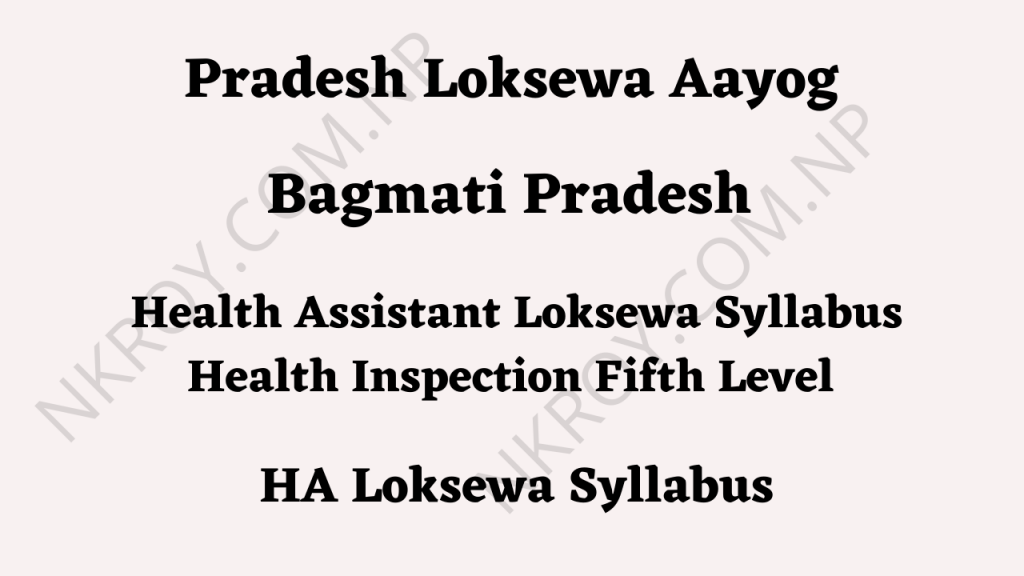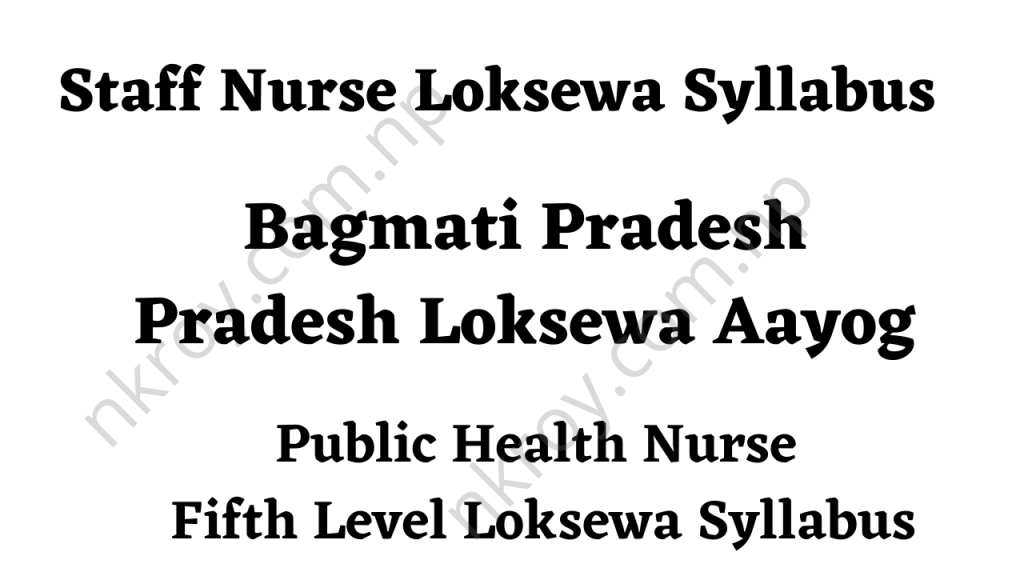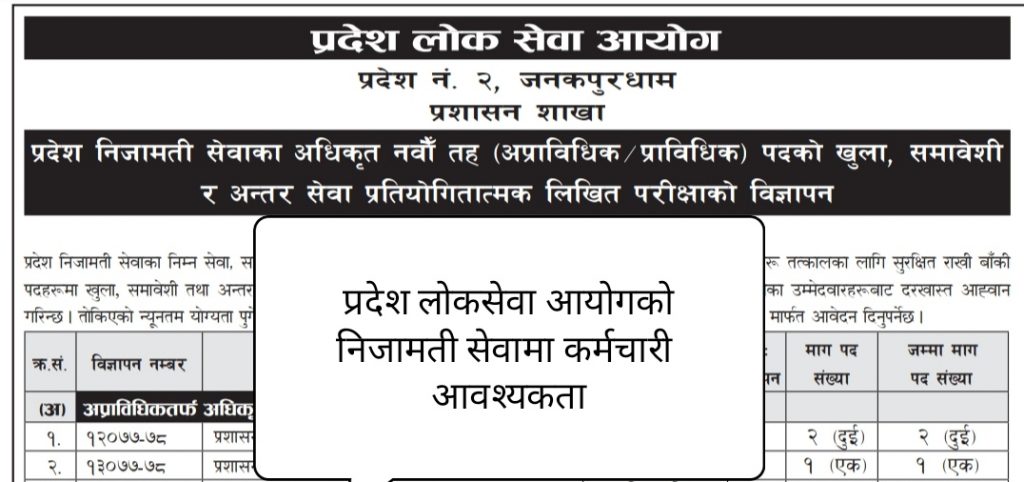Bagmati Pradesh Health Assistant Loksewa Syllabus | Health Inspection Fifth Level HA Syllabus
This syllabus is published by the Public Service Commission of Bagmati Province for Provincial Loksewa Exam.
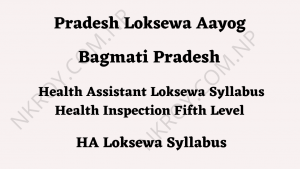
The syllabus is specially designed for ” Nepal Health Service, Health Inspection Group, Fifth Level, Health Assistant, Province Civil Service and Local Government Service “ position open competition written examination. The curriculum is applicable from 2079/09/10.
The Loksewa examination for the above-mentioned post will be conducted in two phases as per the syllabus.
- First Phase: Written Examination Full Marks: 200
- First Paper Full Marks: 100
- Second Paper Full Marks: 100
- Second Phase: Interview Full Marks: 30
First Phase: Written Examination Scheme
First Phase: First Paper Written Examination
- Full Marks: 100
- Pass Marks: 40
- Time: 45 minutes
- First Paper : Part 1
- Subject: General Awareness & General Aptitude Test
- Examination System: Objective Questions [Multiple Choice Questions (MCQs)]
- Number of Questions: 25; each Question consisting 2 Marks [25×2=50]
- First Paper : Part 2
- Subject: Job Related Functional Knowledge
- Examination System: Objective Questions [Multiple Choice Questions (MCQs)]
- Number of Questions: 25; each Question consisting 2 Marks [25×2=50]
First Phase: Second Paper Written Examination
- Full Marks: 100
- Pass Marks: 40
- Time: 2 hours and 15 minutes
- Subject: Job Related Functional Knowledge
- Examination System: Subjective Questions [Short Answer and Long Answer Questions]
- Number of Questions: 12 Short Answer and 4 Long Answer; each Short Answer consisting 5 Marks and Long Answer consisting 10 Marks [12×5=60 and 4×10=40]
Second Phase Examination
- Full marks: 30
- Examination System: Board Interview
Bagmati Pradesh Health Assistant Loksewa Syllabus: First Paper Written Examination
HA First Paper Part 1 Syllabus: General Awareness and General Aptitude Test
25 Questions × 2 Marks = 50 Marks
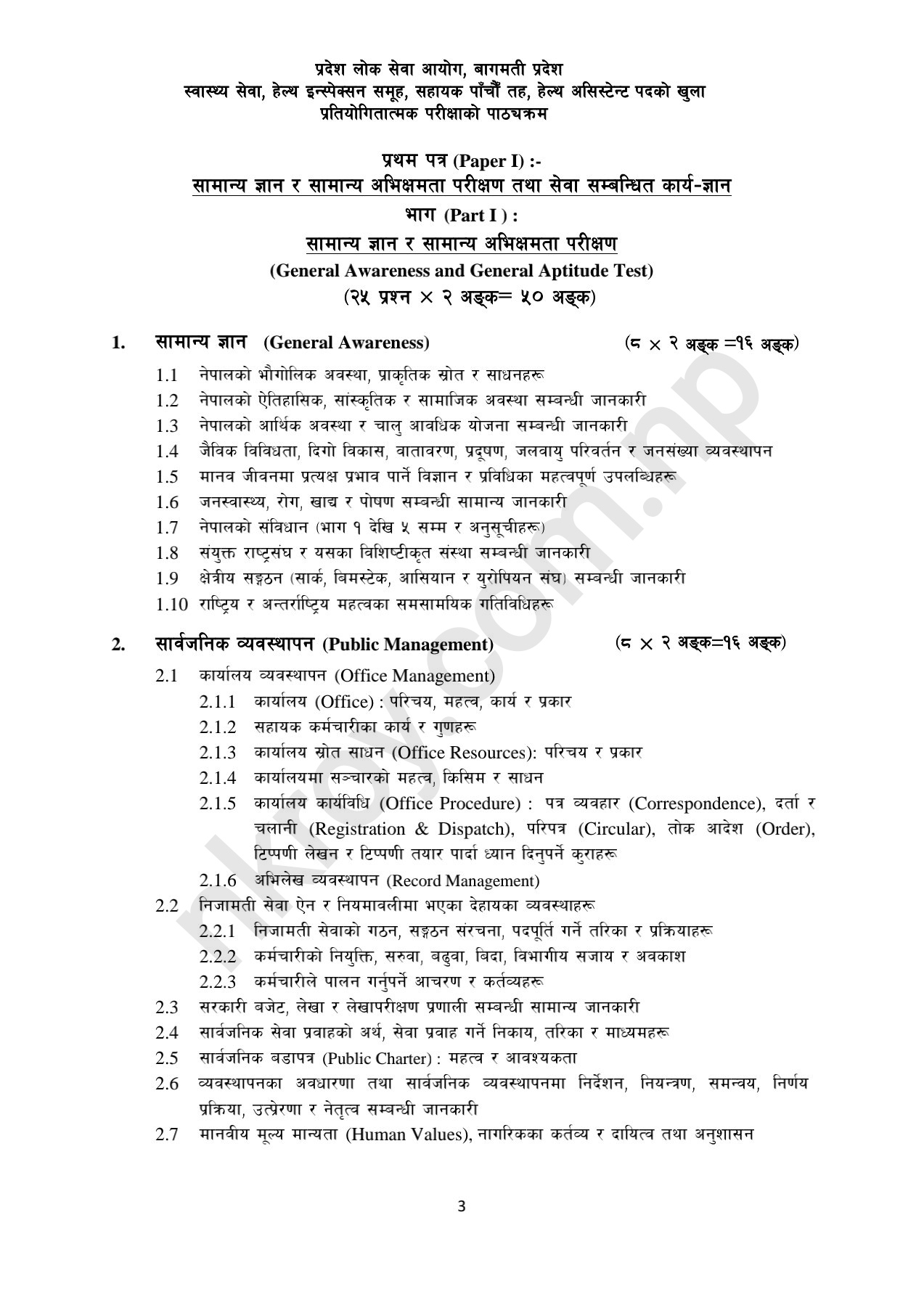
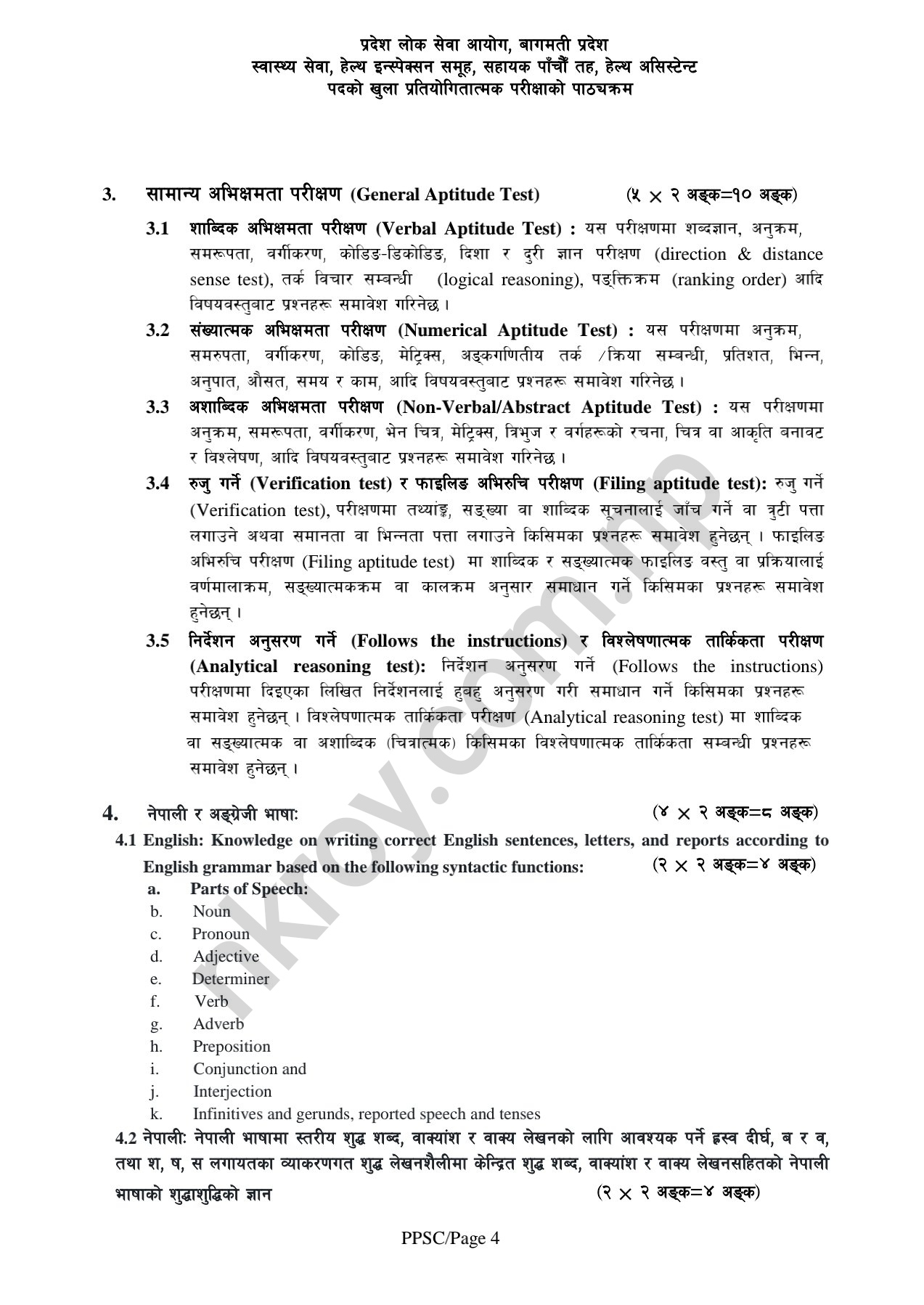
First Paper Part 2 Syllabus: Job Related Functional Knowledge
25 Questions × 2 Marks = 50 Marks
- The examination may be conducted in Nepali or English language or both English and Nepali language.
- The number of questions from each chapter of the curriculum/syllabus will be asked as mentioned below.
| Unit | 1 | 2 | 3 | 4 | 5 | 6 | 7 | 8 | 9 | 10 | 11 | 12 | 13 | 14 | 15 |
| No. of Questions | 5 | 2 | 1 | 1 | 2 | 1 | 2 | 2 | 1 | 1 | 2 | 1 | 1 | 2 | 1 |
- For each right answer, 2 marks will be provided and, 20% marks will be deducted in case of the wrong answer. No marks will be given or deducted if the question is unanswered.
- Only the selected candidates from the first phase of examination will be called for interview in the second phase of the examination.
1. Introduction, Bagamati Province Policy, National Policy, Planning , Strategies and implementation status of Public Health Programmes in Nepal
1.1 Family Planning, Safe Motherhood
1.2 Control of Diarrhoeal Diseases (CDD), Acute Respiratory Diseases (ARI), Nutrition, National Programme on Immunization & Integrated Management of Childhood Illness (IMCI)
1.3 Malaria, Kala-azar, Japanese Encephalitis, Filaria
1.4 Human Immuno-Deficiency Virus (HIV)/Acquired Immuno-Deficiency Syndrome (AIDS) and Sexually Transmitted Diseases (STD) Control
1.5 Tuberculosis and Leprosy Control
1.6 Zoonotic diseases control
1.7 Non Communicable Diseases and Mental Health
1.8 Health Education, Information and communication
1.9 Social Health Security, School Health Nurse, National Health Insurance
1.10 Curative Services in Health Facility, Laboratory services
2. Planning and Management
2.1 Community Health Diagnosis & Health Profile
2.2 Micro Planning of Health Programme
2.3 Supervision, Monitoring and Evaluation of Health Programmes
2.4 Health Management Information System (HMIS)
2.5 Planning and Management of Camps
2.6 Cold Chain Management
2.7 Health Training Management in different settings
2.8 Logistic Management
2.9 Health Provisions on Bagamati Province current Periodic Plan
3. Organizational Structure and Functions
3.1 Federal Level: Ministry of Health and Population (MoHP), Department of Health Service (DoHS), and Central Level agencies
3.2 Provincial Level: Ministry of Social Development, Health Directorate Health Logistics Management Centre, Health Training Center, Public Health Lab, Health Office, Provincial Hospitals
3.3 Local level: Primary Health Care Center (PHCC), Health Post (HP), Sub Health Post (SHP), Urban Health Center, Basic Health Center
4. Community Mobilization & Local Governance
4.1 Female Community Health volunteers (FCHV) and Mother’s Groups
4.2 Primary Health Care Outreach Clinic
4.3 Community Drug Programme (CDP)
4.4 Mobilization of Local Health Leaders and Committees
4.5 Provincial/Local Management of Health Services
5. Epidemiology and Disease Control
5.1 Definition, Scope, Causes of Disease and Infection
5.2 Types and Management of Disasters
5.3 Management of Epidemics
5.4 Causes, Signs, Symptoms, Management, Prevention and Control of Gastroenteritis, Dysentery, Cholera, Typhoid Fever, Giardiasis, Malaria, Filariasis, Encephalitis, Kala-azar, Parasitic Infestation, Scabies, Chicken Pox,
Influenza, Mumps, Rabies, Hepatitis, Ring Worm, Leprosy, Tuberculosis, Helminthiasis, Pertussis, Measles and Diphtheria, Covid-19 and other pandemic diseases
6. Environmental Sanitation
6.1 Water Purification, Waste Management, Food Hygiene, Sanitation of public places, Health Hazards, Sanitary Latrines, Basic Measures in Controlling Rodents, Medical Importance and Measures of Controlling Common Vectors and Insects
7. Child Health Problems and Interventions
7.1 Common Neo-natal Problems
7.2 Common Child Health Problems like CDD, ARI, Malaria and Malnutrition
7.3 Nutritional Interventions, Immunizations Services
8. General Medicine
8.1 General History Taking, Simple Physical Examination, Systemic Examination
8.2 Various Methods of Diagnosis, Complication and Management of Diseases in Respiratory, Digestive, Cardiovascular, Urinary, Endocrine, Hematology and Central Nervous System with its terminology, Etiology and clinical features
9. First Aid and Emergency Management
9.1 Shock, Poisoning, Injuries, Haemorrhage, External bleeding, Thermal and Chemical Burns, Fracture and Dislocation, Frost Bite, Insect bite, Animal bite, Snake bite and Drowning, Abscess and Cellulites
10. Skin Diseases
10.1 Common skin infections (Bacterial, Viral, Fungal and Parasitic) Acute drug reaction
11. Elementary Surgery
11.1 Haemorrhage, Management of inflammation, Septicemia, Toxemia, Sinus, fistula, Gangrene, Wound, Tetanus, Acute Pain Abdomen, , Hernia, Anal Fissure, Piles, Acute Retention of Urine, Causes of Frequent Urination and Nocturia, Management of Rupture of Urethra, Haematuria, Phimosis, Paraphimosis, Hydrocele, Head Injury, Clinical features and management of Osteomyelitis, Local Anesthesia, Sterilization of Surgical Instruments
12. Eye, Ear, Nose and Throat Diseases
12.1 General Examination procedures of Eye, Ear, Nose and Throat
12.2 General Managements of Eye Lid diseases and it’s complications, Red Eyes, Trachoma, Corneal ulcer, Night Blindness, Cataract, Pterygium, Iridocyclitis, Glaucoma and foreign body in the eyes
12.3 Removal of Wax and Foreign Bodies, Sign and Symptoms and Managements of Otitis Media, Otitis Externa and referral conditions of hearing problems
12.4 Epistaxis and Sinusitis
12.5 Clinical Features, Complications and management of Acute Tonsillitis, Pharyngitis and Laryngitis
13. Oral Health and Mental Health
13.1 Dental plaques and calculus, Dental Carries, Periodontitis, Periodontal pockets and Abscess, Importance and Maintenance of Oral Hygiene
13.2 Psychosis, Neurosis and Common Mental Health Problem
14. Reproductive Health Problems and Interventions
14.1 Male and Female reproductive System, mechanism of Menstruation, Conception, Evolution, Vaginal Discharge, Management of Per Vaginal Bleeding, Post Menopausal Bleeding, Uterine Prolapsed, Pelvic Inflammatory Diseases; causes, Sign, Symptoms and Complication of Entopic pregnancy, Management of
Engorgement of Mastitis. and Breast Abscess
14.2 Management of Normal Labor and Early Diagnosis and referral of Complicated Pregnancy, Labor, Puerperium
14.3 Safe Abortions, Permanent and Temporary Contraceptives
15. Acts and Regulations
15.1 Health Service Act and Regulation
15.2 Health Professional Council Act and Regulation
Bagmati Pradesh Health Assistant Loksewa Syllabus: Second Paper Written Examination: Job Related Functional Knowledge
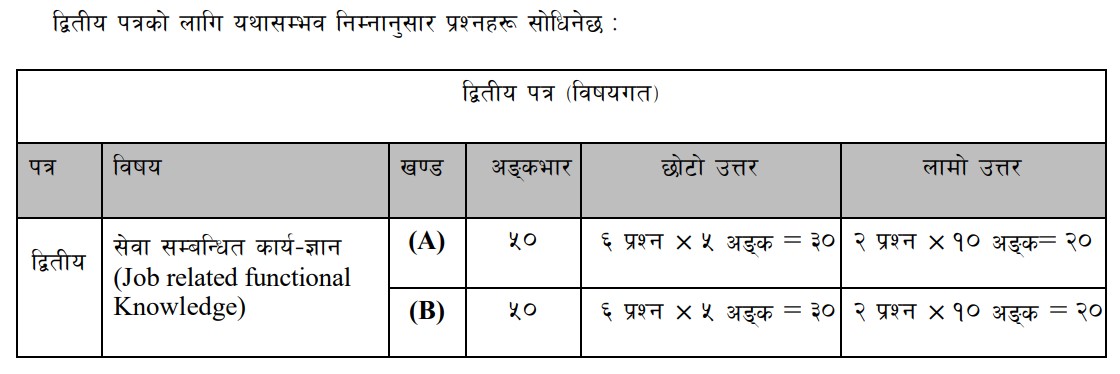
Section A: 50 Marks
1. Introduction, Bagamati Province Policy, National Policy, Planning , Strategies and implementation status of Public Health Programmes in Nepal
1.1 Family Planning, Safe Motherhood
1.2 Control of Diarrhoeal Diseases (CDD), Acute Respiratory Diseases (ARI), Nutrition, National Programme on Immunization & Integrated Management of Childhood Illness (IMCI)
1.3 Malaria, Kala-azar, Japanese Encephalitis, Filaria
1.4 Human Immuno-Deficiency Virus (HIV)/Acquired Immuno-Deficiency Syndrome (AIDS) and Sexually Transmitted Diseases (STD) Control
1.5 Tuberculosis and Leprosy Control
1.6 Zoonotic diseases control
1.7 Non Communicable Diseases and Mental Health
1.8 Health Education, Information and communication
1.9 Social Health Security, School Health Nurse, National Health Insurance
1.10 Curative Services in Health Facility, Laboratory services
2. Planning and Management
2.1 Community Health Diagnosis & Health Profile
2.2 Micro Planning of Health Programme
2.3 Supervision, Monitoring and Evaluation of Health Programmes
2.4 Health Management Information System (HMIS)
2.5 Planning and Management of Camps
2.6 Cold Chain Management
2.7 Health Training Management in different settings
2.8 Logistic Management
2.9 Health Provisions on Bagamati Province current Periodic Plan
3. Organizational Structure and Functions
3.1 Federal Level: Ministry of Health and Population (MoHP), Department of Health Service (DoHS), and Central Level agencies
3.2 Provincial Level: Ministry of Social Development, Health Directorate Health Logistics Management Centre, Health Training Center, Public Health Lab, Health Office, Provincial Hospitals
3.3 Local level: Primary Health Care Center (PHCC), Health Post (HP), Sub Health Post (SHP), Urban Health Center, Basic Health Center
4. Community Mobilization & Local Governance
4.1 Female Community Health volunteers (FCHV) and Mother’s Groups
4.2 Primary Health Care Outreach Clinic
4.3 Community Drug Programme (CDP)
4.4 Mobilization of Local Health Leaders and Committees
4.5 Provincial/Local Management of Health Services
5. Epidemiology and Disease Control
5.1 Definition, Scope, Causes of Disease and Infection 5.2 Types and Management of Disasters
5.3 Management of Epidemics
5.4 Causes, Signs, Symptoms, Management, Prevention and Control of Gastroenteritis, Dysentery, Cholera, Typhoid Fever, Giardiasis, Malaria, Filariasis, Encephalitis, Kala-azar, Parasitic Infestation, Scabies, Chicken Pox, Influenza, Mumps, Rabies, Hepatitis, Ring Worm, Leprosy, Tuberculosis, Helminthiasis, Pertussis, Measles and Diphtheria, Covid-19 and other pandemic diseases
6. Environmental Sanitation
6.1 Water Purification, Waste Management, Food Hygiene, Sanitation of public places, Health Hazards, Sanitary Latrines, Basic Measures in Controlling Rodents, Medical Importance and Measures of Controlling Common Vectors and Insects
Section B: 50 Marks
7. Child Health Problems and Interventions
7.1 Common Neo-natal Problems
7.2 Common Child Health Problems like CDD, ARI, Malaria and Malnutrition
7.3 Nutritional Interventions, Immunizations Services
8. General Medicine
8.1 General History Taking, Simple Physical Examination, Systemic Examination
8.2 Various Methods of Diagnosis, Complication and Management of Diseases in Respiratory, Digestive, Cardiovascular, Urinary, Endocrine, Hematology and Central Nervous System with its terminology, Etiology and clinical features
9. First Aid and Emergency Management
9.1 Shock, Poisoning, Injuries, Haemorrhage, External bleeding, Thermal and Chemical Burns, Fracture and Dislocation, Frost Bite, Insect bite, Animal bite, Snake bite and Drowning, Abscess and Cellulites
10. Skin Diseases
10.1 Common skin infections (Bacterial, Viral, Fungal and Parasitic) Acute drug reaction
11. Elementary Surgery
11.1 Haemorrhage, Management of inflammation, Septicemia, Toxemia, Sinus, fistula, Gangrene, Wound, Tetanus, Acute Pain Abdomen, , Hernia, Anal Fissure, Piles, Acute Retention of Urine, Causes of Frequent Urination and Nocturia, Management of Rupture of Urethra, Haematuria, Phimosis, Paraphimosis, Hydrocele, Head Injury, Clinical features and management of Osteomyelitis, Local Anesthesia, Sterilization of Surgical Instruments
12. Eye, Ear, Nose and Throat Diseases
12.1 General Examination procedures of Eye, Ear, Nose and Throat
12.2 General Managements of Eye Lid diseases and it’s complications, Red Eyes, Trachoma, Corneal ulcer, Night Blindness, Cataract, Pterygium, Iridocyclitis, Glaucoma and foreign body in the eyes
12.3 Removal of Wax and Foreign Bodies, Sign and Symptoms and Managements of Otitis Media, Otitis Externa and referral conditions of hearing problems
12.4 Epistaxis and Sinusitis
12.5 Clinical Features, Complications and management of Acute Tonsillitis, Pharyngitis and Laryngitis
13. Oral Health and Mental Health
13.1 Dental plaques and calculus, Dental Carries, Periodontitis, Periodontal pockets and Abscess, Importance and Maintenance of Oral Hygiene
13.2 Psychosis, Neurosis and Common Mental Health Problem
14. Reproductive Health Problems and Interventions
14.1 Male and Female reproductive System, mechanism of Menstruation, Conception, Evolution, Vaginal Discharge, Management of Per Vaginal Bleeding, Post Menopausal Bleeding, Uterine Prolapsed, Pelvic Inflammatory Diseases; causes, Sign, Symptoms and Complication of Entopic pregnancy, Management of Engorgement of Mastitis. and Breast Abscess
14.2 Management of Normal Labor and Early Diagnosis and referral of Complicated
Pregnancy, Labor, Puerperium
14.3 Safe Abortions, Permanent and Temporary Contraceptives
15. Acts and Regulations
15.1 Health Service Act and Regulation
15.2 Health Professional Council Act and Regulation
If you need to check Health Assistant Loksewa Syllabus of Gandaki Province, you can click the link below:
Health Assistant Loksewa Syllabus of Gandaki Province
Bagmati Pradesh Health Assistant Loksewa Syllabus | Health Inspection Fifth Level HA Syllabus by Nitesh’s Blog.
